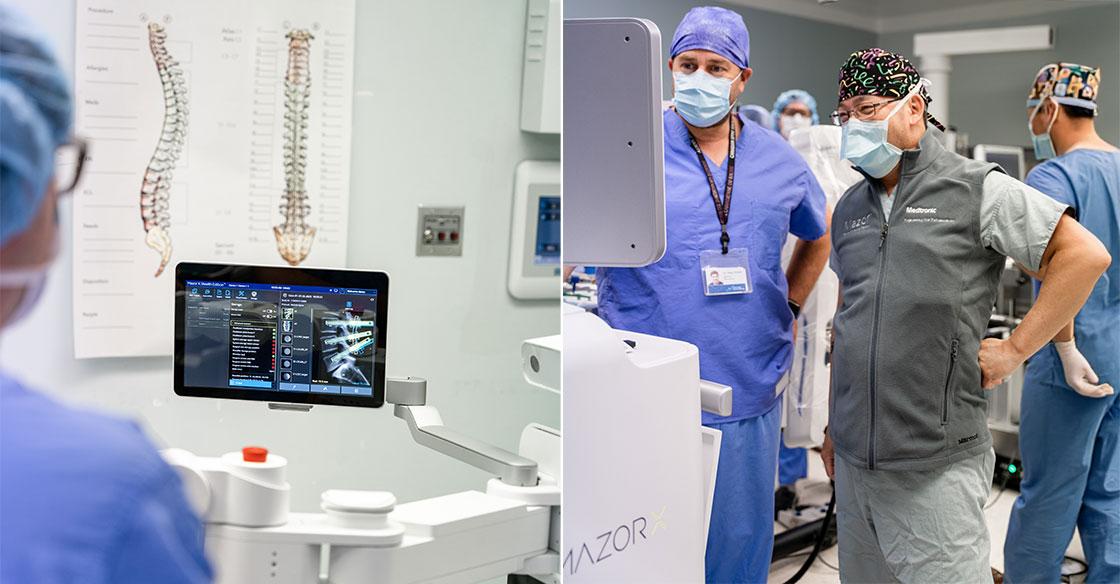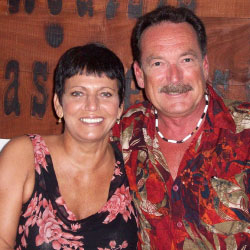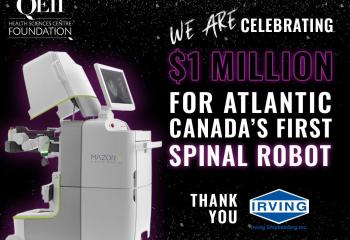
Pictured: The QEII's donor-funded spinal robotics technology, called the MAZOR™ X Stealth Edition.
When Linda Proudfoot woke up one morning unable to walk, she had no idea that cutting-edge robotics technology would be the key to regaining her mobility overnight...
Thanks to the QEII’s expert surgical team and the donor-funded MAZOR X spinal robot, Linda went from being unable to take a single step to walking the very next day — an outcome that still leaves those around her in awe.
“I went to the emergency department in Kentville, and they sent me right to the QEII in Halifax with Dr. [Sean] Christie. That night, he did an operation; a little two-inch incision on my lower spine, assisted by the robot,” Linda recalls.
Linda’s diagnosis of spinal stenosis — a condition that compresses the spinal cord and nerves — had finally put a name to the debilitating pain she had been enduring. Though she had long known arthritis was causing significant deterioration in her spine, she never expected to lose her ability to walk so suddenly.
“Pain had long been an issue, but that day it hit an absolute breaking point — I couldn’t walk, I could barely move,” she says. “I underwent emergency spinal surgery and I was literally walking the very next morning as part of my recovery.”
While the 67-year-old still lives with chronic back and hip pain, she credits the QEII team and the donor-funded technology they had access to for restoring her ability to walk.
“When I tell people about this technology and my experience, their jaws just drop,” says Linda.
HUMAN CONTROLLED. ROBOT ASSISTED. DONOR FUNDED.
No longer an idea confined to science fiction, robot-assisted surgery is becoming a treatment option for more medical conditions than ever before. From spinal care to cancer surgeries, the QEII Health Sciences Centre is a national leader in surgical robotics thanks to the extraordinary generosity of QEII Foundation donors. In fact, the QEII is now home to six surgical robots; five of which are only a reality thanks to donor support through the QEII Foundation’s $100-million We Are campaign.
The QEII’s MAZOR X spinal robot — the technology behind Linda’s life-changing procedure — is no exception. Nearly 100 donors, including Irving Shipbuilding Inc., supported this $3-million project through the We Are campaign.
To date, nearly 100 robot-assisted spinal surgeries have been performed at the QEII — including Canada’s first-ever patient procedure and the nation’s first pediatric scoliosis surgery.
QEII experts are not just users of this robotics technology; they are working side-by-side with industry to help inform how the technology is introduced to other health centres. In fact, according to neurosurgeon Dr. Sean Christie, the QEII is in the final stages of becoming Canada's first and only established training centre for the MAZOR X robot.
“We’re leaders in this space and are playing a big role in helping to teach, train and mentor others who will be utilizing this robotics technology in the future,” says Dr. Christie, QEII neurosurgeon.
Dr. Christie explains that this can involve everything from seeing QEII patient cases and how the robot works firsthand to potential simulation training with cadavers. This important work reinforces the QEII’s role as an overall Robotics Centre of Excellence and how QEII Foundation donors help make it possible.
CONDUCTING LEADING-EDGE RESEARCH
Donor support was the catalyst for introducing groundbreaking spinal robotics technology at the QEII, but it’s also playing a big role in fueling vital research.
This research is essential, not only to measure the impact of spinal robotics but also to provide healthcare teams with the evidence-based data needed to confidently adopt and optimize this technology for patient care.
According to QEII orthopaedic surgeon, Dr. Andrew Glennie, he was initially hesitant about incorporating the spinal robot into his patient cases.
“I was a skeptic initially,” he shares. “I thought, ‘We put pedicle screws in all the time — this isn’t going to make a big difference.’” However, his perspective shifted dramatically after working with the technology firsthand.
“It takes away a lot of the guesswork and the potential mistakes that can occur with these [delicate] spinal surgeries," he explains. “The pinpoint accuracy is incredible.”
According to Dr. Glennie, this increased surgical precision has the power to significantly decrease infection rates; potential impact that QEII teams are working to validate with data and research.
Thanks, in part, to donor support, our QEII experts are conducting studies comparing traditional open surgery to robot-assisted and minimally-invasive techniques.
Dr. Glennie shares that they’re seeing a trend towards lower infection rates when comparing traditional midline open surgeries — procedures which involve making a large incision in the middle of a patient’s back to expose the spine — to “the midline-sparing surgeries that you can get with the robot.”
“It’s pilot data, but it’s promising,” says Dr. Glennie, who explains that these future insights could strengthen the case for this technology’s widespread adoption in even more patient procedures.
Other exciting donor-supported research is examining the spinal robot’s potential to help teams decrease the number of revision surgeries required in the long-run and its cost impact on the healthcare system.
“The other hope that we have for this technology is the reduction of the number of cases that return to the OR,” says Dr. Christie. “Historically, about 1 in 5 patients — so 18 to 20 per cent — come back to us for revision surgery within 10 years. With the robot now available, we’re trying to lower that number."
According to our QEII spine team, by ensuring more precise placement of spinal implants and reducing stress on adjacent areas of the spine, the potential likelihood of further complications decreases. Beyond reducing costs, wait times and pressures on the healthcare system, this can lead to long-term patient benefits, like less deterioration or ‘wear and tear’ on a patient’s discs or joints and the need for additional surgeries.
ADVANCING CARE FOR PATIENTS
As Dr. Glennie shares, the most important impact of the QEII’s spinal robot “is on the lives of our patients”; many of whom are living with severe degenerative conditions that can have a significant impact on an individual’s daily life.

Linda (pictured with her husband) couldn’t agree more.
The Kentville resident says she has a long road ahead as she continues to navigate a life of chronic pain, amidst other critical health issues.
The robotic surgery was just one big step in her journey, as she strives for a pain-free future.
“It’s about quality of life,” explains Linda, who is hopeful that more investments in innovative technology and research — along with increased awareness of the “devastating impacts” of chronic pain — will continue to improve and transform care for future patients. It's a matter she's incredibly passionate about and proud to advocate for.
In the meantime, she’s keeping busy by giving back to seniors in her community, spending time with her three dogs and, when weather permits, her daily walks; an everyday task she never takes for granted.
“Thanks to my robotic surgery, I can walk again,” says Linda. “I’m very grateful to the donors and the entire spinal team for all they did for me — I hope it helps lots more people who are living with this pain.”


